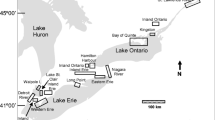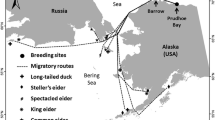Abstract
To assess progress towards virtual elimination of PCBs, DDE, dieldrin and Mirex and their associated physiological effects, we compared their concentrations in pooled livers of adult herring gulls (Larus argentatus) repeatedly sampled at 8 Great Lakes colonies and a reference colony on the Atlantic coast between 1974 and 1993. We measured the relative thyroid mass and concentrations of highly carboxylated porphyrins and retinyl palmitate in the liver of each individual. PCBs, dieldrin and mirex declined in 7 of 8 colonies while DDE decreased in six. The greatest decreases occurred pre-1985. PCBs and DDE did not decrease in gulls from Middle Island in western L. Erie. Middle Island and Saginaw Bay had the highest concentrations of PCBs of 11 Great Lakes colonies in the 1990s. Thyroids of gulls from Great Lakes colonies were slightly enlarged but the degree of enlargement has decreased over time. In 1991, gulls from Great Lakes colonies had slight to moderately elevated concentrations of highly carboxylated porphyrins. In the early 1990s, hepatic stores of retinyl palmitate were very seriously depleted in gulls from the Detroit River, western basin of Lake Erie, and Lake Ontario, reflecting decreased availability and altered storage. We conclude that PCBs and/or other persistent toxic substances in the food of herring gulls have not been virtually eliminated.
Similar content being viewed by others
References
Borgmann, U. and Whittle, D.M.: 1991, ‘Contaminant concentration trends in Lake Ontario lake trout (Salvelinus namaycush): 1977–1988’, J. Great Lakes Res. 17,368–381.
Bowerman, W.W., IV, Kubiak, T.J., Holt, J.B. Jr., Evans, D.L., Eckstein, R.G., Sindelar, C.R., Best, D.A. and Kozie, K.D.: 1994, ‘Observed abnormalities in mandibles of nesting bald eagles Holiaeetus leucocephalus’, Bull. Environ. Contam. Toxicol. 53,450–457.
Corkum, L.D., Ciborowski, J.J.H. and Lazar, R.: 1995, ‘Spatial distributions and contaminant burdens in Hexagenia (Ephemeroptera) populations in western Lake Erie and the Detroit River’, Abstracts of the 38th conference of the International Association for Great Lakes Research, East Lansing, MI, May 28–June 1, 1995.
Eisenreich, S.J., Looney, B.B. and Thornton, J.D.: 1981, ‘Airborne organic contaminants in the Great Lakes ecosystem’, Environ. Sci. Technol. 15,30–38.
Ewins, P.J., Weseloh, D.V., Groom J.H., Dobos, R.Z. and Mineau P.: 1994, ‘The diet of herring gulls (Larus argentatus) during winter and early spring on the lower Great Lakes’, In; Aquatic Birds in the Trophic Web of Lakes, Kerekes, J.J. (ed.) Hydrobiologia 279/280,39–55.
Fox, G.A.: 1993, ‘What have biomarkers told us about the effects of contaminants on the health of fish-eating birds in the Great Lakes? The theory and a literature review’, J. Great Lakes Res. 19,722–736.
Fox, G.A., Allan, L.J., Weseloh, D.V. and Mineau, P.: 1990, ‘The diet of herring gulls during the nesting period in the Canadian waters of the Great Lakes’, Can. J. Zool. 68,1075–1085.
Fox, G.A., Kennedy S.W., Norstrom R.J. and Wigfield, D.C.: 1988, ‘Porphyria in herring gulls: a biochemical response to chemical contamination of Great Lakes food chains’, Environ. Toxicol. Chem. 7,831–839.
Gebauer, M.B. and Weseloh, D.V.: 1993, ‘Accumulation of organic contaminants in sentinel mallards utilizing confined disposal facilities at Hamilton Harbour, Lake Ontario, Canada’, Arch. Environ. Contam. Toxicol. 25,234–243.
Giesy, J.P., Ludwig, J.P. and Tillitt, D.E.: 1994, ‘Deformities in birds of the Great Lakes region: Assigning causality’, Environ. Sci. Technol. 28,128–135.
Gilbertson, M.: 1974, ‘Pollutants in breeding herring gulls in the lower Great Lakes’, Can. Field-Nat. 88,273–280.
Gilbertson, M. and Fox, G.A.: 1977, ‘Pollutant-associated embryonic mortality of Great Lakes herring gulls’, Environ. Pollut. 12,211–216.
Gilbertson, M., Kubiak, T., Ludwig, J. and Fox, G.: 1991, ‘Great Lakes embryo mortality, edema and deformities syndrome (GLEMEDS) in colonial fisheating birds: similarity to chick edema disease’, J. Toxicol. Environ. Health 33,455–520.
Glantz, S.A.: 1992, Primer of Biostatistics. 3rd Ed., McGraw-Hill, Inc., New York.
Grasman, K.A., Fox, G.A., Scanlon, P.F. and Ludwig, J.P.: 1996, ‘Organochlorine-associated immunosuppression in prefledgling Caspian terns and herring gulls from the Great Lakes: An ecoepidemiological study’, Environ. Health Perspect. 104(Suppl. 4),829–842.
Griffiths, R.W., Schloesser, D.W., Leach, J.H. and Kovalak, W.P.: 1991, ‘Distribution and dispersal of the zebra mussel (Dreissena polymorpha) in the Great Lakes region’, Can. J. Fish. Aquat. Sci. 48,1381–1388.
Harris, H.J., Erdman, T.C., Ankley, G.T. and Lodge, K.B.: 1993, ‘Measures of reproductive success and polychlorinated biphenyl residues in eggs and chicks of Forster's terns on Green Bay, Lake Michigan, Wisconsin — 1988’, Arch. Environ. Contam. Toxicol. 25,304–314.
Harris, H.J. and Holden, C.: 1990, The State of the Bay, A Capsule Review. The Institute of Land and Water Studies, The University of Wisconsin-Green Bay, Green Bay.
Hebert, C.E., Norstrom, R.J., Simon, M., Braune, B.M., Weseloh, D.V. and Macdonald, C.R.: 1994, ‘Temporal trends and sources of PCDDs and PCDFs in the Great Lakes: Herring gull egg monitoring, 1981–1991’, Environ. Sci. Technol. 28,1268–1277.
Hebert, C.E., Weseloh, D.V., Kot, L. and Glooschenko, V.: 1994, ‘Organochlorine contaminants in a terrestrial foodweb on the Niagara Peninsula, Ontario, Canada 1987–89’, Arch. Environ. Contam. Toxicol. 26,356–366.
Heinz, G.H., Miller, D.S., Ebert, B.J. and Stromborg, K.L.: 1994, ‘Declines in organochlorines in eggs of red-breasted mergansers from Lake Michigan, 1977–1978 versus 1990’, Environ. Monit. Assess. 33,175–182.
Hermanson, M.H., Christensen E.R., Buser, D.J., and Chen, L-M.: 1991, ‘Polychlorinated biphenyls in dated sediment cores from Green Bay and Lake Michigan’, J. Great Lakes Res. 17,94–108.
Hewitt, M., Servos, M., Van Der Kraak, G., Solomon, K., and Munkittrick, K.R.: 1996, ‘Characterization of bioactive 3-trifluoromethyl-4-nitrophenol (TFM) lampricide formulation impurities’. Organohalogen Compounds 29,434–438.
Jaffe, R., Stemmler, E.A., Eitzer, B.D. and Hites, R.A.: 1985, ‘Anthropogenic, polyhalogenated, organic compounds in sedentary fish from Lake Huron and Lake Superior tributaries and embayments’, J. Great Lakes Res. 11,156–162.
Kennedy, S.W., Fox, G.A., Trudeau, S., Bastien, L.J. and Jones S.P.: 1998, ‘Highly carboxylated porphyrin concentrations: a biochemical marker of PCB exposure in herring gulls’. Mar. Environ. Res. (in press).
Kennedy, S.W., Wigfield, D.C. and Fox, G.A.: 1986, ‘Tissue porphyrin determination by high-speed high-performance liquid chromatography’, Anal. Biochem. 157,1–7.
Kennedy, S.W. and James C.A.: 1993, ‘Improved method to extract and concentrate porphyrins from liver tissue for analysis by high-performance liquid chromatography’, J. Chromatog., Biomed. Appl. 619,127–132.
Koslowski, S.E., Metcalfe, C.D., Lazar, R., and Haffner, G.D.: 1994, ‘The distribution of 42 PCBs, including three coplanar congeners, in the food web of the western basin of Lake Eric’, J. Great Lakes Res. 20,260–270.
Kubiak, T.J., Harris, H.J., Smith, L.M., Schwartz, T.R., Stalling, D.L., Trick, J.A., Sileo, L., Docherty, D.E. and Erdman, T.C.: 1989, ‘Microcontaminants and reproductive impairment of the Forster's tern on Green Bay, Lake Michigan — 1983’, Arch. Environ. Contam. Toxicol. 18,706–727.
Lake Ontario Committee: 1993, Signs of Change in the Lake Ontario Ecosystem. Ontario Minsitry of Natural Resources and the New York Department of Environmental Conservation.
Ling, H., Diamond, M. and Mackay, D.: 1993, ‘Application of the QWASI fugacity/aquivalence model to assessing sources and fate of contaminants in Hamilton Harbour’, J. Great Lakes Res. 19,582–602.
L'Italien S. and Struger, J.: 1995, ‘Pesticide concentrations in water and suspended sediment in Lake Erie’. Abstracts of the 38th Concerence of the International Association for Great Lakes Research, East Lansing, MI, May 20–June 1, 1995.
Ludwig, J.P., Auman, H.J., Kurita, H., Ludwig, M.E., Campbell, L.M., Giesy, J.P., Tillitt, D.E., Jones, P., Yamashita, N., Tanabe, S. and Tatsukawa, R.: 1993, ‘Caspian tern reproduction in the Saginaw Bay ecosystem following a 100-year flood events’, J. Great Lakes Res. 19,96–108.
Mineau, P., Fox, G.A., Norstrom, R.J., Weseloh, D.V., Hallett, D.J. and Ellenton, J.A.: 1984, ‘Using the herring gull to monitor levels and effects of organochlorine contamination in the Canadian Great Lakes’, in; Toxic Contaminants in the Great Lakes, J.O. Nriagu and M.S. Simmons (eds.), J. Wiley and Sons, New York. pp. 425–452.
Moccia, R.D., Fox, G.A. and Britton, A.: 1986, ‘A quantitative assessment of thyroid histopathology of herring gulls (Larus argentatus) from the Great Lakes and a hypothesis on the causal role of environmental contaminants’, J. Wildlife Dis. 22,60–70.
Moll, R.A., Jude, D., Rossmann, R., Kantak, G.V., Barres, J., DeBoc, S., Giesy, J. and Tuchman, M.: 1995, ‘Movement and loadings of inorganic contaminants through the lower Saginaw River’, J. Great Lakes Res. 21,17–24.
Munkittrick, K.R., Servos, M.R., Parrott, J.L., Martin V., Carey, J.H., Flett, P.A. and Van Der Kraak, G.J.: 1994, ‘Identification of lamprieide formulations as a potent inducer of MFO activity in fish’, J. Great Lakes Res. 20,355–365.
Nicholls, K.H. and Hopkins, G.J.: 1993, ‘Recent changes in Lake Erie (north shore) phytoplankton: cumulative impacts of phosphorus loading reductions and the zebra mussel introduction’, J. Great Lakes Res. 19,637–647.
Norman, M. and Greenwood, P.H.: 1963, A History of Fishes. Ernest Brown Ltd, London, UK.
Norstrom, R.J., Hallet, D.J., Onuska, F.I. and Comba, M.E.: 1980, ‘Mirex and its degradation products in Great Lakes herring gulls’, Environ. Sci. Technol. 14,860–866.
Oliver, B.G. and Bourbonniere, R.A.: 1985, ‘Chlorinated contaminants in surficial sediments of Lakes Huron, St. Clair, and Erie: Implications regarding sources along the St. Clair and Detroit Rivers’, J. Great Lakes Res. 11,366–372.
Peakall, D.B., Norstrom, R.J., Rahimtula, A.D. and Butler, R.D.: 1986, ‘Characterization of mixed-function oxidase systems of the nestling herring gull and its implications for bioeffects monitoring’, Environ. Toxicol. Chem. 5,379–385.
Roberts, J.W. and Veley, R.J.: 1995, ‘Loads, yields, and transport relations of nutrients, chloride, and suspended sediments in three Lake Erie tributaries in Ohio’, Abstracts of the 38th conference of the International Association of Great Lakes Research, East Lansing, MI, May 28–June 1, 1995.
Russell-Hunter, W.D.: 1970, Aquatic Productivity: An Introduction to Some Basic Aspects of Biological Oceanography and Limnology. The Macmillan Co., New York.
Simpson, K.L., Katayama, T. and Chichester, C.O.: 1981, ‘Carotenoids in fish feeds’, in; J.C. Baurenfeind (ed), Carotenoids as Colorants and Vitamin A Precursors, Academic Press, New York, pp. 463–538.
Spear, P.A., Moon, T.W. and Peakall, D.B.: 1986, ‘Liver retinoid concentrations in natural populations of herring gulls (Larus argentatus) contaminated by 2,3,7,8-tetrachlorodibenzo-p-dioxin and in ring doves (Streptopelia risoria) injected with a dioxin analogue’, Can. J. Zool. 64,204–408.
Stow, C.A.: 1995, ‘Great Lakes herring gull egg PCB concentrations indicate approximate steady-state conditions’, Environ. Sci. Technol. 29,2893–2897.
Strachan, W.M.J. and Edwards, C.J.: 1984, ‘Organic pollutants in Lake Ontario’, In: J.O. Nriagu and M.S. Simmons (eds.), Toxic Contaminants in the Great Lakes, J. Wiley and Sons, New York, pp. 425–452.
Suns, K.R., Hitchin, G.G. and Toner, D.: 1993, ‘Spatial and temporal trends of organochlorine contaminants in spottail shiners from selected sites in the Great Lakes (1975–1990)’, J. Great Lakes Res. 19,703–714.
Velleux, M. and Endicott, D.: 1994, ‘Development of a mass balance model for estimating PCB export from the lower Fox River to Green Bay’, J. Great Lakes Res. 20,416–434.
Verbrugge, D.A., Giesy, J.P., Mora, M.A., Williams, L.L., Rossmann, R., Moll, R.A. and Tuchman, M.L.: 1995, ‘Concentrations of disolved and particulate polychlorinated biphenyls in water from the Saginaw River, Michigan’, J. Great Lakes Res. 21,219–235.
Weseloh, D.V., Mineau, P. and Struger, J.: 1990, ‘Geographical distribution of contaminants and productivity measures of herring gulls in the Great Lakes: Lake Erie and connecting channels 1978/9’, Sci. Total Environ. 91,141–159.
White, D.H. and Cromartie, E.: 1977, ‘Residues of environmental pollutants and shell thinning in merganser eggs’, Wilson Bull. 89,532–542.
Whittle, D.M., Kiriluk, R.M., Carswell, A.A. and Keir, M.J.: 1995, ‘Recent changes in the dynamics and rate of contaminant accumulation in the Lake Erie aquatic community’. Abstracts of the 38th conference of the International Association for Great Lakes Research, East Lansing, MI, May 28–June 1, 1995.
Zar, J.H.: 1984, Biostatistical Analysis. Prentice-Hall Inc., Englewood Cliffs, NJ.
Zile, M.H.: 1992, ‘Vitamin A homeostasis endangered by environmental pollutants’. Proc. Soc. Expt. Biol. Med. 201,141–153.
Author information
Authors and Affiliations
Rights and permissions
About this article
Cite this article
Fox, G., Trudeau, S., Won, H. et al. Monitoring the Elimination of Persistent Toxic Substances from the Great Lakes; Chemical and Physiological Evidence from Adult Herring Gulls. Environ Monit Assess 53, 147–168 (1998). https://doi.org/10.1023/A:1005987821104
Issue Date:
DOI: https://doi.org/10.1023/A:1005987821104




